The South West of Easter Island, or Rapa Nui, is easily accessible on foot, by bicycle, motorbike, or car. Just beyond the Iorana Hotel is s sign hot to get to the Ana Kai Tangata; a must see if you interested in rock art. But the highlight of this part of the island must be the view over the Rano Kau crater, filled with water and little reed islands, with nearby the ceremonial village of Orongo and its beautiful petroglyfs.
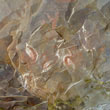 Ana Kai Tangata:
Ana Kai Tangata:
The Ana Kai Tangata cave, lies south of Hanga Roa, on the slopes of Rano Kau, where you can see beautiful ancient paintings on the ceiling. The paintings are probably depictions of flying sterns, which relate to the Tangata Manu, the Birdman. Ana Kai Tangata cave and literally means Eating People Cave, suggesting that there were cannibalism rituals practised here by the Bird Man religion.
Take Note: Be careful of high tides. The cave is only just above sea level, and sometimes fills up with water.
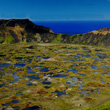 Rano Kau:
Rano Kau:
324m above sea level you can look into an extinct volcano crater, with a diameter of 1.5 km. The crater is filled with fresh water, and has many green reeds islandsfloating on top. In 1880, during an expedition an Ahu with Moai was found along the crater’s edge. But in 1914 was the Moai had disappeared, people suspect it fell down by soil erosion and broke apart on the cliffs below.
Tip: Hiking along the crater’s edge is allowed, and be prepared for stunning views.
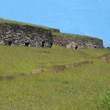 Orongo Village:
Orongo Village:
The ceremonial village of Orongo consists of 54 stone houses, with stone roofs which are covered with grass. People are not sure whether the houses were always inhabited or only used during ceremonies. Until the first half of the 19th century Orongo was the centre of the Birdman cult, where annually a race was held get the first egg of the Manutara, stern, wich had to be collected on the little island of Moto Nui.
.
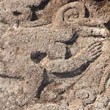 Petroglyfs:
Petroglyfs:
The houses of the Orongo village have many modified stones wich are decorated with petroglyfs. These engraved stones are mostly representations of the Tangata Manu, the Birdman, as well as female fertility symbols such as Komari, or vulva. But there are also petroglyfs of the Make Make, the creator of mankind. The Make Make has a mask-shaped face with large eyes.
.
.
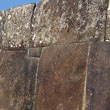 Vinapu I – Ahu Tahiri:
Vinapu I – Ahu Tahiri:
The complex consists of 2 Ahu, Vinapu I, and II, and is one of the largest ceremonial complexes of Rapa Nui. The platforms are hewn from basalt blocks that weigh tons and are super tightly fit against each other, similar to some walls in Cuzco in Peru and Tiahuanaco in Bolivia. On the one side of Ahu Vinapu I, also known as Ahu Tahiri, lies a Moai head and on the other side are 6 Moai, in pieces.
.
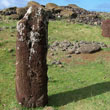 Vinapu II – Female Moai:
Vinapu II – Female Moai:
The wall of the Ahu Vinapu II might not fit together as smooth and tightly as Vinapu I, but right next to it, is a very special female Moai, albeit in poor condition. The Moai is made of red scoria, and bears no loincloth, such as her many male variants. If you look closely, you can see her arms resting along her body, and close to the ground is a visible vulva. From ancient times it is known that the Moai had 2 faces.
.
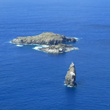 The 3 Motu – Motu Nui, Motu Iti and Motu Kao Kao:
The 3 Motu – Motu Nui, Motu Iti and Motu Kao Kao:
Just off the southwest coast of Easter Island there are 3 small slands: Motu Kao Kao, Moto Iti and Moto Nui. Moto means island in the Rapa Nui language, and Moto Nui is the largest island of the 3, and best-known because of the race to bring the first stern egg to shore during the Birdman cult. On the island there are several caves with engravings and paintings.
Tip: It is possible to take a boat ride to see the islands up close.
Tip: Between Motu Nui and Moto Kao Kao there is great diving.

